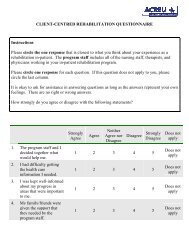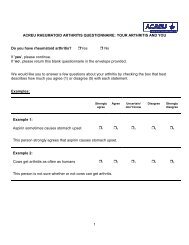Client-Centred Rehabilitation - Arthritis Community Research ...
Client-Centred Rehabilitation - Arthritis Community Research ...
Client-Centred Rehabilitation - Arthritis Community Research ...
Create successful ePaper yourself
Turn your PDF publications into a flip-book with our unique Google optimized e-Paper software.
49<br />
programs such as the <strong>Arthritis</strong> Self<br />
Management Program provide an<br />
excellent model for involvement of<br />
such organizations in the rehab<br />
system<br />
3) Components of the <strong>Rehabilitation</strong> System<br />
Our findings echo the need for a<br />
number of the components of the<br />
rehabilitation system identified in Managing<br />
the Seams (Provincial <strong>Rehabilitation</strong><br />
Reference Group, MOHLTC, 2000)<br />
particularly those addressing the need for:<br />
multiple, identified access points; service<br />
coordination; and, transition out of<br />
rehabilitation services. These components<br />
all address the need for systems and<br />
processes that make navigating the system<br />
easier for clients.<br />
♦ Structures and systems that facilitate<br />
transitions within the system,<br />
especially between hospital based<br />
services and community services,<br />
need to be developed. These<br />
transitions are not unidirectional.<br />
Options for re-entering or reaccessing<br />
the system also need to be<br />
available. Ideally, clients would have<br />
a key contact person or primary<br />
conduit of information across the<br />
various stages of the rehabilitation<br />
system. This will require:<br />
♦ Educational and information<br />
materials for clients and<br />
providers. Resources will<br />
be required to develop,<br />
evaluate, and distribute<br />
client and provider<br />
educational materials.<br />
♦ Systems to catalogue or<br />
monitor the availability of<br />
community services and<br />
rehabilitation programs.<br />
♦ <strong>Research</strong> to evaluate health service<br />
delivery models that address<br />
coordination and integration activities<br />
such as effective interteamwork.<br />
♦ Systems to allow sharing of client<br />
information across/between programs<br />
4) In addition to system level structures and<br />
processes, organizational systems and<br />
structures that support client-centred<br />
rehabilitation need to be identified. It is<br />
unrealistic to expect Health Care<br />
Professionals to practice in a client-centred<br />
manner if they are working in a system or<br />
organization that is not client-centred. This<br />
would require:<br />
♦ Resources to support in house<br />
training of clinicians in clientcentred<br />
practice<br />
♦ Reimbursement systems that<br />
reward/allow time to educate the<br />
client. For example, reimbursement<br />
based on the number of visits<br />
rewards the number of clients seen<br />
and does not allow comparison of<br />
services across organizations.<br />
Reimbursement by the hour rewards<br />
clinicians for taking the time to<br />
educate clients and allows<br />
comparison of like services across<br />
organizations. This is particularly<br />
important for clients with chronic<br />
diseases where education about selfmanagement<br />
is critical.<br />
♦ Resources to support the evaluation<br />
of client-centred care through the use<br />
of outcome measures and client<br />
satisfaction questionnaires.<br />
Personnel and structures will need to<br />
be implemented to administer this<br />
data collection and utilize data.<br />
5) Further research is needed to better<br />
understand the processes and outcomes of<br />
client-centred rehabilitation.








